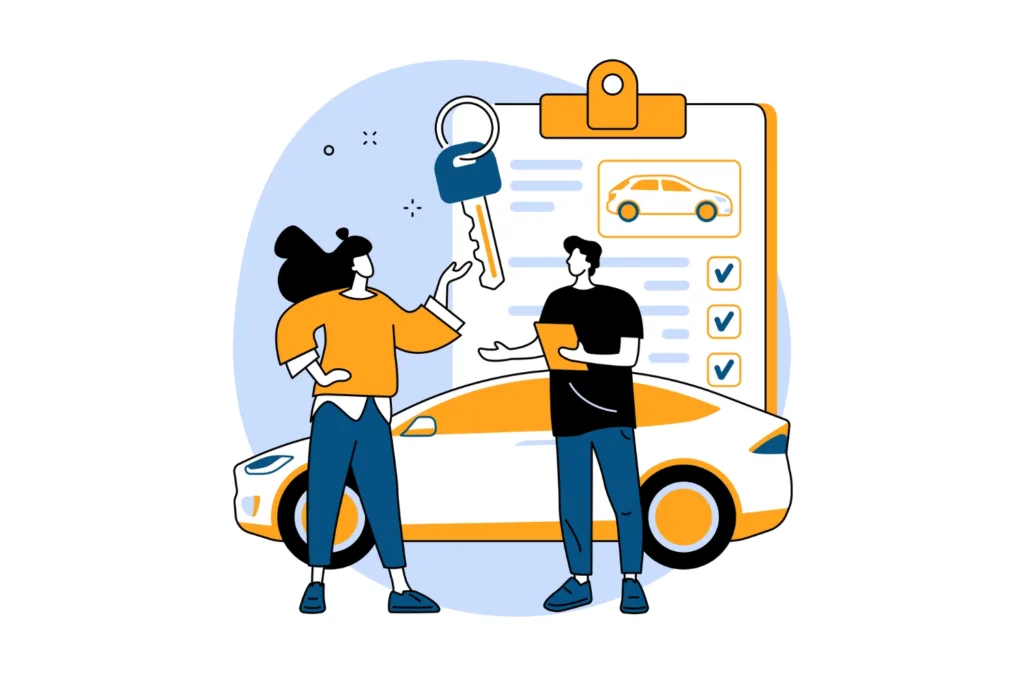Whether you’re a dealership or auto parts retailer, investing in automotive SEO is essential to your bottom line. It helps your business show up on Google when consumers search for relevant information, services, and products you offer online.
If you aren’t optimizing your SEO marketing strategy for search engines, your brand is basically invisible online to users you want to reach, especially in an oversaturated digital market. You may already be creating SEO content or utilizing Google Business Profile.
But, are they generating the results you’re looking for?
Auto dealers often make mistakes with their SEO marketing, like using the wrong search intent for blogs or keyword stuffing their websites—which is common! You’re not expected to be an SEO expert. But as a result, you may not see high keyword rankings or web copy that doesn’t convert to sales.
Our complete automotive SEO marketing guide walks you through the best practices and mistakes to avoid. That way, you can better drive your dealership to the top of the search engine results page (SERP).
A Guide to Automotive SEO & Content Marketing to Drive Traffic for Your Dealership
Automotive search engine optimization (SEO) has many facets, including content marketing, local SEO, and more. However, they all share the same focus—generating traffic to your website by strengthening your online visibility. Some SEO automotive marketing strategies have additional end goals, such as converting paid search ads to sales.
Below are the SEO essentials your auto brand must know to meet your SEO goals effectively.
Invest in Local SEO for Your Local Dealership

SEO for the automotive industry is especially crucial for local dealerships and auto part retailers with physical stores. You need to reach local target audiences while standing out from competitors nearby.
That’s where local SEO comes in.
You know local consumers read your reviews and check how you compare to the competition to see if your online reputation is trustworthy. While you may have a Google Business Profile (GBP), it may not be optimized fully or marketed correctly to target local audiences.
Some automotive SEO tips for GBP include:
- Optimizing your business description and image file names with target keywords
- Creating weekly posts to cross-promote your blogs
- Responding personally to all reviews over template-based responses, including your negative ones
- Diversifying your GBP posts’ call-to-actions (CTAs), like “Learn More” or “Sign Up”—people aren’t always ready to “Buy Now” especially vehicles since they’re a larger purchase
Create Valuable & Optimized Automotive Blog Topics for All Funnel Stages
You know each customer is unique. Every driver isn’t always car-savvy. Some may only know basic information to look for when car shopping, like vehicle history, entertainment features, and test drive comfort. Others may have more technical knowledge, like understanding the powertrain they want for a work vehicle.
A vehicle is a significant investment. Drivers nowadays are conducting preliminary research to ensure they’re making the right choice in their car purchase. Creating blogs for users in all funnel stages is key to meeting them where they are in their buyer’s journey by providing valuable, relevant content.
The three funnel marketing stages with automotive blog topic examples are:
- Top-of-Funnel (TOF): How to Buy Your First Car, # Mistakes to Avoid When Purchasing a Used Pickup—for users who need more guidance on basic vehicle information
- Middle-of-Funnel (MOF): 2023 vs. 2024 Jeep Wrangler: What’s New, Best Light Duty Pickup Trucks of 2024—for more educated users who need help deciding between options
- Bottom-of-Funnel (BOF): Auto Part Spotlight: Duramax’s New Diesel Engine, Customer Success Story, New Test Drive Videos—for users who are ready to buy
In addition to valuable funnel content, you must optimize all blogs for users and Google to find online, including:
- Adding backlinks from reputable sites with high Domain Authority to be a trustworthy resource in your industry’s niche—arguably the top keyword ranking factor in SEO!
- Using target keywords throughout the body and headings naturally to prevent keyword stuffing
- Following the right keyword density per your blog’s word count to make it readable for users
- Including internal links to other blogs and web pages naturally to prevent over-optimizing
- Cross-promoting your blogs by sharing them on your automotive social media profiles
Keyword Research Tips for Automotive Blogs

We mentioned common SEO mistakes auto dealers make, like using the wrong search intent in their blogs. Search intent means exactly that—the intent behind a user’s search.
The four types of search intent with automotive keyword examples are:
- Informational (TOF): car financing tips, used car buying mistakes to avoid, etc.
- Commercial (MOF): best electric vehicles 2024, tesla cybertruck vs. gmc hummer ev, etc.
- Navigational (BOF): auto parts stores in denver co, car dealerships near me, etc.
- Transactional (BOF): used pickup trucks for sale, hybrid cars for sale, etc.
If a user searches for “vehicles for sale in manhattan” and you create a blog topic on “How to Find the Best Vehicles for Sale in Manhattan,” that’s not what they’re looking for. They’re searching for Manhattan vehicle product listings, not a blog with tips on finding one because it’s a transactional search intent.
You can verify a keyword’s search intent by simply typing it into Google and checking the SERPs. Do the SERPs show all blogs or product pages? While some keywords may have mixed search intent, if the SERPs don’t show blogs, it’s not the right search intent for your blog content.
If you don’t know where to begin with your keyword research, start by conducting a competitor SERP analysis. Enter a keyword into Google and perform a content audit with your SEO software of the top-ranking competitors. Content audits allow you to see which keywords they’re using and uncover content opportunities where you can outrank.
For example, you might find many question-based keywords related to a blog topic you’re writing about. You can take this opportunity to create an FAQ section to rank for those keywords if your competition didn’t make one.
Optimize Your Website for Search Engines & Users
As mentioned earlier, another common mistake auto dealers make with their SEO is keyword stuffing their websites in hopes of higher rankings. This practice can do the opposite and harm your keyword rankings instead.
Google prioritizes E-E-A-T content (Experience, Expertise, Authoritativeness, & Trustworthiness) to deliver more helpful, relevant information when searching for information. If your website is over-optimized with keywords, it makes your content’s readability less enjoyable and weakens your user experience (UX).
Remember, you’re also writing for humans, not just search engines.
Other common SEO mistakes include not optimizing your site for mobile devices or creating a separate website for your blog. A recent study shows that 33% of car shoppers use mobile devices to research vehicles online, and 60% of them would call a dealership from a call extension link.
Additionally, hosting your blog elsewhere is basically like having two different websites. Automotive SEO is comprehensive enough. Optimizing for two sites creates more challenges, and your end goal is to drive more traffic to your main site.
Website optimization must include on-page, off-page, and technical SEO:
- On-page SEO is optimizing what’s on your website pages, like keywords and internal links.
- Off-page SEO is optimizing what’s off your website pages, like backlinks and social media.
- Technical SEO is optimizing what’s behind your website’s page, like loading speed.
While this may seem like a lot of information to digest, don’t get overwhelmed with this part. SEO tools and software platforms, like SEMRush and Ahrefs, automate website optimizations for you. Through website audits, they’ll flag areas of your site needing optimization, which types, and how to do it.
Some automotive SEO tips for website optimizations include:
- Implement a search bar with filters on your parts page so users can easily find and shop for products
- Add QR codes to your specials page so consumers can download coupons and redeem limited-time offers faster
- Write web copy for your services page so potential customers know what’s included in each of your offerings
- Optimize your website for desktop and mobile to prevent people leaving from poor user experience (UX), like small text on smartphones and no site breadcrumbs
- Include target keywords in your metadata, like headings, meta descriptions, and page URLs, for Google to crawl (discover) and index (store) easier
Website optimizations are about making it easier for your users and Google to discover online.
Promote Your Inventory with Google’s Vehicles for Sale & Vehicle Listing Ads

In addition to generating organic traffic, auto dealer SEO should promote paid traffic to your website. Also known as search engine marketing (SEM) or Pay-Per-Click (PPC), it boosts your search engine rankings through paid search ads. However, aligning your SEO and SEO marketing strategies can produce optimal results for automotive brands.
Remember, some users are ready to purchase a vehicle (transactional intent) or are comparing local providers before purchasing (commercial intent). The difference with SEO is that it focuses more on informational search intent and research-oriented queries, like “car buying tips.”
Combining SEO and SEM allows your brand to cover all relevant vehicle-related keywords consumers use when searching online. And, Google makes it easy for automotive brands to do so with its Vehicles for Sale and Vehicle Listing Ads.
The Vehicles for Sale feature allows auto dealers to integrate their inventory directories directly into Google’s search results via your Google Business Profile. Users can apply search filters and browse your inventory outside your website to learn more about a specific vehicle. It also links back to your site when they’re ready to buy.
The Vehicle Listing Ads feature matches your vehicle inventory data feed within Google Merchant Center to provide a personalized shopping experience via advertising. Google matches specific car details users search for by displaying relevant vehicle ad listings. They enter the features they want, like location, mileage, and price, and an ad listing is shown.
Monitor Your SEO Marketing Strategies
While everything we mentioned is auto dealer SEO best practices, that doesn’t mean it’ll always generate the results you want. Google’s algorithm and car consumer demands are consistently changing—especially with various technologies disrupting the SEO landscape, like AI content writing and Search Generative Experience.
Continuously monitoring your SEO marking strategies helps you measure their success with data-driven insights.
Key SEO metrics to track include:
- Organic Traffic: Number of users who entered your site without paid search
- Keyword Rankings: New, improved, and lost rankings
- Clicks: Number of users who clicked on your website
- Impressions: Number of users your website was displayed to
- New Backlinks: Number of websites linking back to your site from theirs
- Top Pages: Website pages that generated the most traffic
- Local SEO Visibility: Number of calls, clicks, and search views of your Google Business Profile
- Indexed Pages: Number of pages that Google indexed (stored) in their database, including those that couldn’t be indexed
While KPIs will vary depending on your SEO goals, you can find these metrics in Google Analytics, Google Search Console, and SEO platforms.
Turbocharge Your Dealership’s Online Traffic with an Auto SEO Agency
As an auto dealer, driving sales and investing in SEO can be time-consuming. You have to manage your company and your trade while understanding the importance of SEO.
Let our automotive SEO experts do the heavy lifting for you. At Reach Marketing Pro, we have extensive SEO experience in the automotive industry. We’ve worked with used and branded car dealerships and auto parts brands to enhance their online presence for their bottom line.
From website designs and optimizations to multiple GBP location management and content writing, we can supercharge your SEO efforts for optimal results. We’re fully transparent with in-depth monthly SEO reporting to continuously measure your strategy’s success.
What makes us stand out is our tailored automotive SEO services.
Our Dealer VIP Program boosts sales for your vehicles in production like SEO content writing for the customer reservation process and designing custom home page slider graphics.
Our Absorption Boost package streamlines your customer’s buying process, like mobile QR codes to scan specials easily within OEM and Google’s guidelines.
Ready to rev up your automotive brand’s rankings?
Learn more about our SEO services or contact us for help today!

